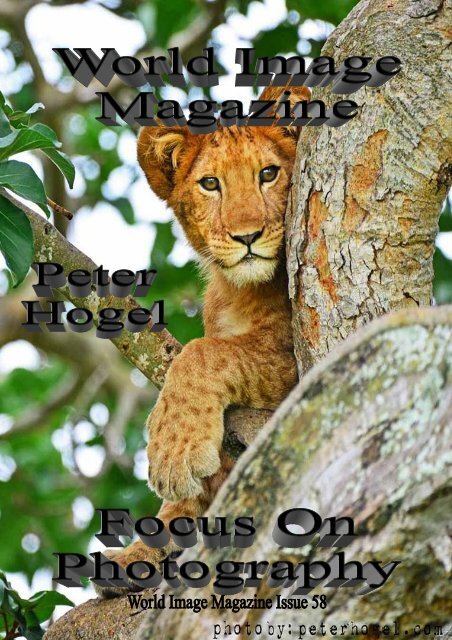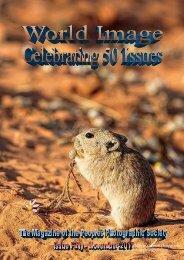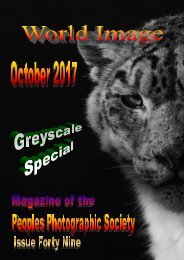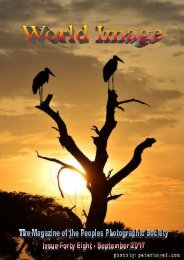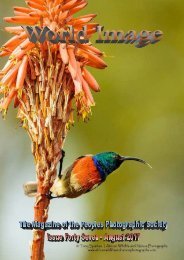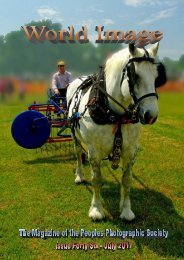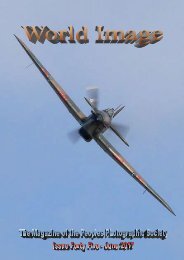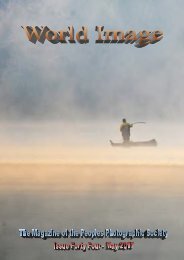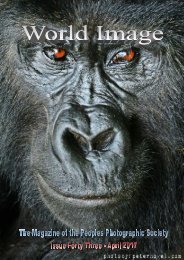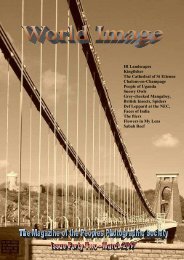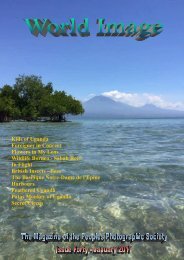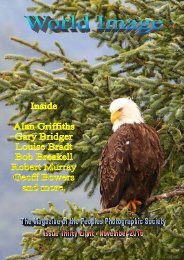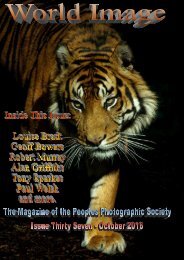World Image Issue 51 Focus On Peter Hogel
An introduction to the freelance photographer Peter Hogel. This is the trial for the new format of the World Image Magazine.
An introduction to the freelance photographer Peter Hogel. This is the trial for the new format of the World Image Magazine.
- No tags were found...
You also want an ePaper? Increase the reach of your titles
YUMPU automatically turns print PDFs into web optimized ePapers that Google loves.
Website = photosociety.net Page 1 email = magazine@photosociety.net
This is <strong>Peter</strong> <strong>Hogel</strong>, a Swedish national born 1967. Walking a path as freelance photographer with a studio<br />
in Stockholm taking on most Photography jobs offered.<br />
<strong>Peter</strong> <strong>Hogel</strong> is a wildlife photographer and guide with 32<br />
years of professional photography. He has travelled in<br />
more than 35 countries around the globe capturing and<br />
freezing life’s moments in photos.<br />
<strong>Peter</strong> is experienced in photography of several different<br />
aspects which include; Architecture, People, products,<br />
wildlife and nature.<br />
After a lifetime of travelling in 2012 he ended up in<br />
Tanzania to run photography safaris, a great opportunity<br />
to combine his passion for wildlife with photography.<br />
He later moved to where he now lives next door to the<br />
mountain gorillas of Bwindi, Uganda and with his great<br />
love and passion for nature, he currently does wildlife<br />
photography in and around Uganda.<br />
Website = photosociety.net Page 2 email = magazine@photosociety.net
In this issue we have decided to focus on Swedish photographer <strong>Peter</strong> <strong>Hogel</strong> who has, more<br />
recently, been working in Uganda. <strong>Peter</strong> is an exceptional photographer working mainly in<br />
the field of Wildlife where his two favourite subjects could not be further apart and yet so<br />
close together, gorillas and insects.<br />
Global Journey? Well five continents is a good start. North &<br />
south America, Australia, Asia, Europe, Africa and Canada.<br />
When journeying through different places and cultures it is<br />
easy to focus on the people images of which can be as varied<br />
as the societies in which they reside. Marrakech is no<br />
exception, from the upwardly mobile businessman to the poor<br />
labourer and all those in between, not forgetting those who<br />
have past their prime and are just plain tired.<br />
Some places in the world are naturally thought of as being grey<br />
and dull, while others are considered to be bright and lively,<br />
both are totally wrong viewpoints for the most part. Writing<br />
this I have two countries in mind but will refrain from naming<br />
them in the interest of good global relations.<br />
Then we get places like Marrakech. Marrakech is place of form<br />
and colour, a former imperial city in western Morocco and is a<br />
major economic center. It is also full of culture and colour.<br />
That being said my own first realisation that there was a place<br />
with that name was from a song by Crosby, Stills & Nash<br />
called "Marrakesh Express”.<br />
© Please remember that all articles and images published in this magazine are copyright protected<br />
Website = photosociety.net Page 3 email = magazine@photosociety.net
To be honest I do not even know<br />
for certain that they have a<br />
railway which is where my<br />
thoughts wander, it could just as<br />
easily be a fast boat across the<br />
Atlantic. (ed).<br />
So back to form and colour. The<br />
form is there if you look for it,<br />
be it in the harbour with the<br />
fishing boats or at the market<br />
with the fish neatly arranged.<br />
Colour comes in the same<br />
manner and more with the<br />
various foods displayed as<br />
colourful hillsides.<br />
Of course it is not necessary to<br />
take the picture as nature<br />
intended every time, sometimes<br />
it is worth trying a new approach<br />
such as the show stall where it<br />
adds impact just to throw in a<br />
curve ball.<br />
Website = photosociety.net Page 4 email = magazine@photosociety.net
Costa Rica is another place as rich<br />
in the wonders of the natural world<br />
as many others. If you like green it<br />
is rich indeed as it contains part of<br />
the rain forest.<br />
Costa Rica is a country of rugged<br />
rain forest with coastlines on both<br />
the Caribbean sea and Pacific<br />
ocean. With about a quarter of its<br />
area is made up of protected jungle,<br />
Costa Rica its rain forest is teeming<br />
with wildlife.<br />
The trees alone display a wide<br />
variety of form in shades of greens<br />
and browns while the quiet rivers<br />
flow beneath.<br />
Website = photosociety.net Page 5 email = magazine@photosociety.net
The rivers start with the<br />
rainfall and end in the<br />
oceans, and in Costa Rica<br />
those same rivers act as<br />
highways and byways<br />
through the lush forest.<br />
The eventually reach the<br />
sea or ocean depending<br />
on which way the water<br />
flows, and the beaches<br />
are another thing the<br />
country is famous for.<br />
Although in discussing this<br />
we are also discussing the<br />
photography of <strong>Peter</strong> <strong>Hogel</strong><br />
and <strong>Peter</strong> can always find<br />
subjects that please the eye<br />
and draw the viewer into the<br />
picture.<br />
But <strong>Peter</strong> can also ‘see’ the<br />
images that fool the eye, and<br />
by using his skill with the<br />
camera and his knowledge of<br />
photography, can deceive as<br />
these two common subjects<br />
serve to prove.<br />
Website = photosociety.net Page 6 email = magazine@photosociety.net
Another aspect of its diversity is the wildlife<br />
which, as those who know <strong>Peter</strong> will know, is<br />
one of his main interests when travelling. He is<br />
never usually without his camera and , one of the<br />
prerequisites for a good photographer (well any<br />
Photographer really) his observational skills are<br />
very well attuned.<br />
That skill at observing the area around him and<br />
actually seeing what is there keeps him at the<br />
forefront of his profession. Keeping your eyes<br />
open and being alert can have many advantages,<br />
including those involving personal health and<br />
wellbeing.<br />
You do not want to meet this chap while<br />
paddling in the river.<br />
Costa Rica is also on the Pacific Rim and, like all<br />
countries in that position, has its volcano. In this<br />
case the Arenal Volcano which still poses a<br />
threat to the environment.<br />
Volcano Arenal, still active.<br />
Top of "Volcano Arenal" still smoking....<br />
I suppose you could walk to the top and take a<br />
look, but much easier to do it from an aircraft.<br />
There are drawbacks with both options, and<br />
advantages.<br />
<strong>On</strong> foot you get to see and photograph all the<br />
scenery and wildlife of the forest, the drawback<br />
is that it may decide to erupt with you standing<br />
on the summit.<br />
In the aircraft you get to see the summit without<br />
getting tired or burnt, the drawback is that you<br />
miss the photo opportunities afforded by walking<br />
through the forest.<br />
Such are the difficult decisions in life that we<br />
must face. Of course you could be like <strong>Peter</strong> and<br />
do both.<br />
Walking through the rain forest will present<br />
some challenges, getting through the jungle is<br />
the least of them.<br />
In the rain forest wildlife has adapted to make<br />
the most of its environment, using camouflage<br />
and colour to blend in with the variety of plants<br />
and flowers.<br />
Snakes can be found close to the ground, and<br />
while most will move away as you approach,<br />
some might not.<br />
Website = photosociety.net Page 7 email = magazine@photosociety.net
Others will be hiding in trees and bushes watching, not necessarily for you but<br />
for their next meal, wave an unsuspecting finger in their direction and that<br />
could be classed as lunch at which point both you and the snake get a nasty<br />
shock.<br />
Those visitors that suffer from<br />
arachnophobia need not apply,<br />
but for <strong>Peter</strong> <strong>Hogel</strong> this forest is<br />
heaven on earth, arachnids<br />
abound in every bush and crevice.<br />
Scary as they might appear,<br />
spiders are more afraid of people<br />
so if you can get past the phobia<br />
and get up close with the camera<br />
a world of diversity appears.<br />
Not all spiders hide their presence,<br />
some use stunning colours to display<br />
their beauty to the world, we only<br />
need to look.<br />
Looking is something these predators<br />
do very well. The frogs are, in some<br />
respects, very like the spiders in that<br />
they are more often seen in the trees<br />
or hanging out on leaves waiting for<br />
their next meal.<br />
I only have one question in<br />
regards to frogs, Why are they<br />
always smiling? ed.<br />
Website = photosociety.net Page 8 email = magazine@photosociety.net
Ok so we all expect to find birds in trees, after all that is their<br />
task in life, apart from raising young and finding food. Costa<br />
Rica is no different to most other places except it has more of<br />
them in a greater variety of colour and form.<br />
Other creatures found in the trees which are normally associated with<br />
ground living are the lizards . These come in all colours and sizes, but it<br />
often takes a quick eye and even quicker reactions to get the picture..<br />
Luck plays a very important part in getting the one special image. If you<br />
wait for the lizard to lose its footing it won’t, But occasionally it happens<br />
and when it does has the camera been in the wrong setting or aimed the<br />
wrong way, or in the old days … run out of film?<br />
Nature has no interest in you getting the perfect picture, <strong>Peter</strong>s answer<br />
when asked the question was simple, “practice, practice, luck and more<br />
practice.”<br />
Website = photosociety.net Page 9 email = magazine@photosociety.net
Primates abound in Costa Rica and while some , like these two, definitely have an attitude problem,<br />
others are a little more placid.<br />
Walking anywhere can be rewarding and this<br />
is especially true in woodlands and forests.<br />
Walk slow, don’t talk, and most of all stop<br />
and listen on a regular basis.<br />
<strong>Peter</strong> like any photographer worth their salt<br />
will tell you that the vast majority of wildlife<br />
pictures do not come from seeing the subject,<br />
but from first hearing them.<br />
It is the ear that detects the sound before the<br />
eye can spot the cause.<br />
Actually they do not care about the<br />
photographer or anyone else for that<br />
matter, so long as they keep a reasonable<br />
distance.<br />
A long lens and a steady hand are very<br />
useful tools in the art of wildlife<br />
photography.<br />
We say that based on the premise that<br />
most photography is done within a short<br />
walk of the car.<br />
In rain protected forest the car may<br />
allow you to get to an area, but if you<br />
intend an extended walk or a climb up<br />
the volcano, then a big heavy lens is not<br />
recommended.<br />
Website = photosociety.net Page 10 email = magazine@photosociety.net
Now I believe that somewhere I mentioned<br />
<strong>Peter</strong> <strong>Hogel</strong>s love of insects.<br />
Their world is a giant world. I sometimes<br />
wonder if they realise just how small they are<br />
or how large the world really is, or even if they<br />
care.<br />
From <strong>Peter</strong>s photography in this area you soon<br />
realise that there is absolutely no privacy when<br />
it comes to the camera.<br />
It is an interesting fact that if the insects turned on humanity, humanity<br />
would lose by sheer weight of numbers.<br />
They can get almost everywhere, and have a huge variety of<br />
form and colour. Often they adopt a disguise, a leaf by any other<br />
name may be an insect, and their eyes always seem to be<br />
watching when seen in close-up.<br />
Website = photosociety.net Page 11 email = magazine@photosociety.net
Speaking of eyes, this is about as close as you might want to get to this desirable creature.<br />
Costa Rica is also a land of people, and what you see depends on how you see. It would have been a simple<br />
matter to stand on the street and take another picture of another person doing another step in their daily<br />
routine, but gain height and you gain a new perspective on the world and in doing so open up a new scope<br />
for photography.<br />
Website = photosociety.net Page 12 email = magazine@photosociety.net
Everywhere we go we can see and photograph people<br />
doing people things whether it be sport or work, but lets<br />
not forget the random opportunity when fate takes a hand.<br />
<strong>Peter</strong> moved into Tanzania before changing location to the<br />
neighbouring country of Uganda.<br />
He admits that he has had the privilege of living in Uganda,<br />
with its tremendously diverse wildlife and stunning nature, for the past six months he has as well been<br />
fortunate enough to work and live just outside one of the national parks, Ishasha sector of Queen Elizabeth<br />
and he means just outside, going to bed hearing the sounds of the hyenas in the night.<br />
He has been running safaris in Uganda for four and a half years, returning to the parks frequently, but<br />
actually living there is different.<br />
The moon slowly rises through the trees and the warm glow in the sky intensifies the sounds of the night<br />
emanating from the forest and parklands around.<br />
Website = photosociety.net Page 13 email = magazine@photosociety.net
When he goes shopping in the nearest village, the best road there goes<br />
through the park so I keep passing through.<br />
After a while he started recognizing the monkeys around and he “got to<br />
know” the elephants, their individual moods and behaviour, he says its<br />
amazing to feel the connection to such a place, and this season has been<br />
extraordinary… <strong>Peter</strong> continued ...<br />
The young family of lions in the<br />
southern part of the park, have<br />
cubs. The three sisters and the<br />
young brother are sticking<br />
together and they had four cubs<br />
about 8 months old (father of the<br />
cubs was a male coming for a<br />
visit from another part of the<br />
park, its not the brother.).<br />
We started to see the cubs when very small<br />
and could follow their progress and growth<br />
and sometime back, the big step for them,<br />
to become part of the famous “tree<br />
climbing lions of Ishasha” when they were<br />
big enough to start climbing the fig trees.<br />
They are now very comfortable tree climbers tho’ lions aren’t very<br />
good climbers I have to say, far from as gracious as the leopard,<br />
occasionally stumble around up on the branches …but very<br />
comfortable when finding the right branch to spend half a day<br />
sleeping on, not even bothering standing up to pee.<br />
The cubs are grooving and so does the young lions, we see a change<br />
in territory coming , splitting up and finding new grounds, and we<br />
are looking forward to it, its good changes, more prides in a park<br />
that have not only space for it but also plenty of food to go around.<br />
Occupying an estimated 1,978 square kilometres (764 sq mi), the<br />
Queen Elizabeth National Park is located in the Western Region of<br />
Uganda. It extends from Lake George in the north-east to Lake<br />
Edward in the south-west and includes the Kazinga Channel<br />
connecting the two lakes and spans the districts of Kasese,<br />
Kamwenge, Rubirizi and Rukungiri, and includes the<br />
Maramagambo Forest.<br />
Website = photosociety.net Page 14 email = magazine@photosociety.net
It borders the Kigezi Game Reserve, the Kyambura Game Reserve, and the Kibale National Park in<br />
Uganda, and the Virunga National Park in the Democratic Republic of the Congo.<br />
The park was founded in 1952 as Kazinga National Park. It was<br />
renamed two years later to commemorate a visit by Queen<br />
Elizabeth II.<br />
The park is known for its wildlife, including African buffalo, Ugandan kob, hippopotamus, Nile crocodile,<br />
African bush elephant, African leopard, lion, and chimpanzee. It is home to 95 mammal species and over<br />
500 bird species.<br />
The area around Ishasha in Rukungiri District is famous for its<br />
tree-climbing lions, whose males sport black manes. The park is<br />
also famous for its volcanic features, including volcanic cones<br />
and deep craters, many with crater lakes, such as the Katwe<br />
craters, from which salt is extracted.<br />
Its been a great time in Ishasha and I hope to be around for<br />
a long time!.. <strong>Peter</strong><br />
Website = photosociety.net Page 15 email = magazine@photosociety.net
Did we mention the snakes?<br />
Probably but not in Uganda.<br />
Then allow us to introduce you to<br />
Toxicodryas blandingii, commonly<br />
known as Blanding's cat snake or<br />
Blanding's tree snake, is a species of<br />
rear-fanged venomous snake of the<br />
family Colubridae. The species is<br />
endemic to Sub-Saharan Africa.<br />
The dark is the male and the light is<br />
the female … just in case you were<br />
wondering.<br />
<strong>On</strong> the previous page we mentioned in passing the Kibale National Park here in Uganda. The park is the<br />
home of the Mountain Gorillas of the Kibale Forest.<br />
This is a species that is under constant threat. <strong>Peter</strong> has spent many hours photographing these intelligent<br />
and social creatures and we hope that can persuade <strong>Peter</strong> to supply enough pictures and information to<br />
dedicate a future issue to this subject.<br />
So for now we will leave you with the smiling face of hope.<br />
Website = photosociety.net Page 16 email = magazine@photosociety.net
Back Again? - <strong>On</strong>ly Time Will Tell<br />
In our last issue of the magazine dated November 2017 I stated that it would be the last in<br />
its current form. This was due to two situations, first my own time limitations due to a<br />
house move and subsequent renovations, and second the possibility of the magazine<br />
becoming interactive so that contributors could generate their own articles or so that I<br />
could create an open input magazine. These latter options never materialised so the<br />
magazine went into a state of hibernation.<br />
However the on-line groups continued and some of the diehard contributors have been<br />
keeping it alive while my attention has been elsewhere. Thank You All.<br />
All the earlier issues are still available to read on line at Yumpu.com or through<br />
worldimagemag.com<br />
After some consultation we have decided to issue the magazine in a new format of which<br />
this is the pilot issue. Publication will be on an ad-hoc basis thus removing the time<br />
constraints on the editor and also the reliance on obtaining submissions for editorial. It still<br />
does not ‘pay you money’ but it is an opportunity to ‘get you out there’.<br />
<strong>Focus</strong> on Photography will do exactly what it says, each issue will focus on either a<br />
photographer, a subject, or both.<br />
Photographers wishing to ‘join in’ with this project may do so with pleasure, buy quality<br />
of picture and taste in subject matter published will be at the sold discretion of the editor<br />
whose decision is final.<br />
Website = photosociety.net Page 17 email = magazine@photosociety.net


